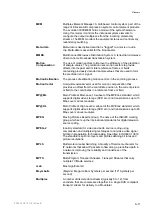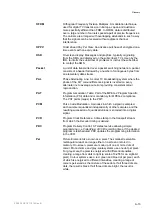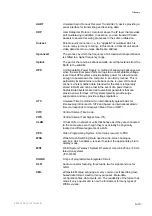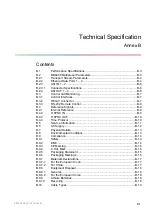
Glossary
OFDM
Orthogonal Frequency Division Multiplex: A modulation technique
used for digital TV transmission in Europe, Japan and Australia;
more spectrally efficient than FDM. In OFDM, data is distributed
over a large number of carriers spaced apart at precise frequencies.
The carriers are arranged with overlapping sidebands in such a way
that the signals can be received without adjacent channel
interference.
OPPV
Order ahead Pay Per View: An advance purchase of encrypted one-
time events with an expiry date.
OSD
On-screen display: Messages and graphics, typically originating
from the SMS, and displayed on the subscriber’s TV screen by the
IRD, to inform the subscriber of problems or instruct the subscriber
to contact the SMS.
Packet
A unit of data transmitted over a packet switching network. A packet
consists of a header followed by a number of contiguous bytes from
an elementary data stream.
PAL
Phase Alternating Line: A colour TV broadcasting system where the
phase of the R-Y colour-difference signal is inverted on every
alternate line to average out errors providing consistent colour
reproduction.
PAT
Program Association Table: Part of the MPEG-2 Program Specific
Information (PSI) data and is mandatory for MPEG-2 compliance.
The PAT points (maps) to the PMT.
PCM
Pulse Code Modulation: A process in which a signal is sampled,
each sample is quantized independently of other samples, and the
resulting succession of quantized values is encoded into a digital
signal.
PCR
Program Clock Reference: A time stamp in the transport stream
from which the Decoder timing is derived.
PDC
Program Delivery Control: A Teletext service allowing simple
programming (i.e. VideoPlus) of VCR recording times. If the desired
program is rescheduled, PDC updates the programming information
in the VCR.
Pel
Picture Element: Also known as a pixel. The smallest resolvable
rectangular area of an image either on a screen or stored in
memory. On-screen, pixels are made up of one or more dots of
colour. Monochrome and grey-scale systems use one dot per pixel.
For grey-scale, the pixel is energized with different intensities,
creating a range from dark to light (a scale of 0-255 for an eight-bit
pixel). Colour systems use a red, green and blue dot per pixel, each
of which is energized to different intensities, creating a range of
colours perceived as the mixture of these dots. If all three dots are
dark, the result is black. If all three dots are bright, the result is
white.
2/1553-FGC 101 1014 Uen B
A-13
Содержание MX8400
Страница 1: ...MX8400 Multiplexer Software Version 5 2 0 and later REFERENCE GUIDE 2 1553 FGC 101 1014 Uen B...
Страница 26: ...Installing and Powering Up 2 1553 FGC 101 1014 Uen B 2 4 BLANK...
Страница 94: ...Operating the Multiplexer using nCompass Control 2 1553 FGC 101 1014 Uen B 4 18 BLANK...
Страница 96: ...Preventive Maintenance and Fault finding 2 1553 FGC 101 1014 Uen B 5 2 BLANK...
Страница 146: ...Technical Specification 2 1553 FGC 101 1014 Uen B B 20 BLANK...
Страница 148: ...Static Parameters 2 1553 FGC 101 1014 Uen B C 2 BLANK...
Страница 150: ...Static Parameters 2 1553 FGC 101 1014 Uen B C 4 Figure C 1 Typical Static Parameter Editor Display...
Страница 186: ...Redundancy Modes 2 1553 FGC 101 1014 Uen B E 2 BLANK...
Страница 192: ...IP Protocols 2 1553 FGC 101 1014 Uen B F 2 BLANK...
Страница 196: ...IP Protocols 2 1553 FGC 101 1014 Uen B F 6 Figure F 3 Editing Stack Download Ports...
Страница 198: ...ProMPEG FEC Support for IP Streaming 2 1553 FGC 101 1014 Uen B G 2 BLANK...
Страница 204: ...Setting up the SFN Functionality 2 1553 FGC 101 1014 Uen B H 2 BLANK...
Страница 212: ...Setting up the SFN Functionality 2 1553 FGC 101 1014 Uen B H 10 BLANK...
Страница 214: ...PSIG Support 2 1553 FGC 101 1014 Uen B I 2 BLANK...
Страница 220: ...BISS Support 2 1553 FGC 101 1014 Uen B J 2 BLANK...
















































